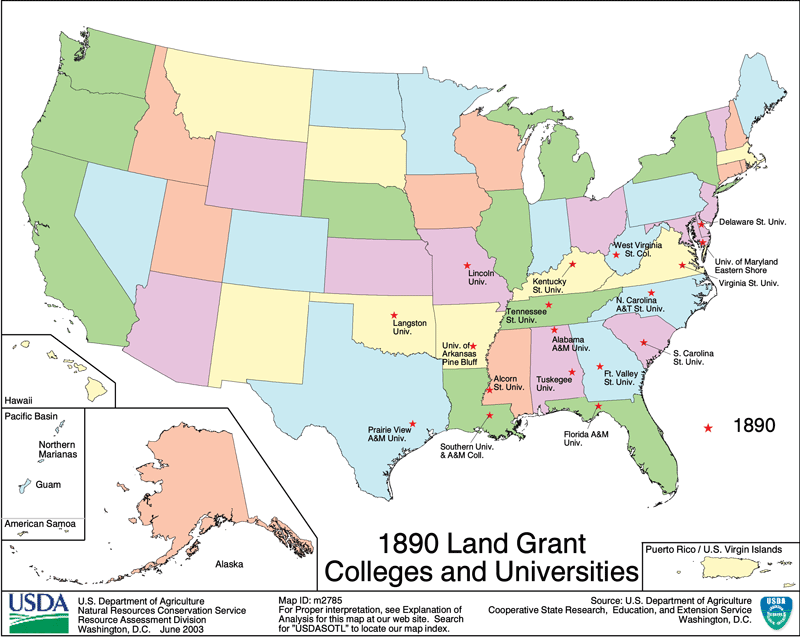Tackling Food Insecurity? Fund Agro-HBCUs
Food insecurity rates, with the highest such rates in Black communities, should prompt aggressive support for agriculture-focused HBCUs or 1890 Land Grant Universities
Publisher’s Riff
A Congressional hearing this Wednesday is set to highlight the significance of Agro-HBCUs: Historically Black Colleges and Universities, many of them historic 1890 Land Grant Universities, which specialize in teaching, training and preparing students for the agriculture sciences. Members of Congress, while hearing testimony from Agro-HBCU leaders, will consider and demand increased levels of federal funding for those institutions as a way to 1) continue supporting the academic and research functions of HBCUs that play a critical role in the nation’s food supply sector and 2) create permanent and strong scholarship programs at Agro-HBCUs which will persuade more Black students entering college to pursue critical agriculture science studies.
This hearing and other discussions among state and federal policymakers sit against the backdrop of very alarming food insecurity rates in Black communities. Agro-HBCUs/1890 Land Grant Universities, with increased funding and resources, could be the key to reducing or altogether eliminating those disparities.
The State of Food Insecurity
Recent research shows nearly 10 million additional Americans found themselves experiencing food insecurity due to the economic disruptions of pandemic. That’s 10 million that we know of. While much of the conversation focused on unemployment, reduced work hours and a lost workforce, there hasn’t been as much focus on households - and, especially, children - losing food as a direct result of lost income.
Research estimates from the University of Illinois’ Craig Gundersen found a 3 percentage point increase in food insecurity rates between 2019 (11 percent) and 2020 (14 percent); child food insecurity rates rose nearly 5 percentage points in the same time period.
Food insecurity spiked at the height of pandemic and, if it wasn’t for a combination of stimulus checks, fast recovering supply chains and a much more resilient agriculture sector than expected, it would have been much higher. The good news is that initial data signal the rates stabilizing … at least temporarily. The bad news is a deeper look at data underscoring the usual racial disparities: Black communities are among those facing the highest rates of food insecurity, particularly in comparison to their White counterparts.
Food Insecurity By Race
Household food insecure rates with children were the highest among Black populations, according to a Guardian study of Census data …
As Feeding America data show …
States with the highest overall food insecurity rates are also places with the highest concentrations of Black residential populations …
1890 Land Grant Locations
It just so happens that the vast majority of states with a combination of 1) large Black population concentrations and 2) high food insecurity rates that disproportionately impact Black and low-income/economically disadvantaged populations are places the house the long-standing specialized 1890 Land Grant universities, the majority of which are also designated HBCUs. These are primarily “Agro-HBCUs” or Historically Black Colleges and Universities that place special emphasis on agriculture science related degrees and career development.
They are also 3) located in states and regions with large agricultural and other land-driven industries. Degree programs at 1890 institutions include …
Agriculture
Agricultural Business/Management
Agricultural Economics
Agricultural Engineering/Mechanics
Agricultural Production and Technology
Agronomy or Crop Science
Animal Sciences
Botany
Food Sciences/Technology
Forestry and Related Sciences
Home Economics/Nutrition
Horticulture
Natural Resources Management
Soil Conservation/Soil Science
Farm and Range Management
Other related disciplines, (e.g. non-medical biological sciences, pre-veterinary medicine, computer science)
Federal Funding
In essence, 1890 Land Grant or Agro-HBCUs represent the framework for a national Black-led infrastructure to tackle high Black food insecurity rates while, simultaneously, opening the doors for increased Black STEM/STEAM advancement in critical agriculture science industries. Agriculture science is also a fast-growing global sector that will find itself increasingly relied upon as climate crisis continues having devastating impacts on food supplies and economically distressed populations. The 1890 agro-HBCUs support the development and scale-up of that infrastructure; to continue doing that, enhanced federal funding will be needed. Funding for critical 1890 Land Grant and agro-HBCUs is already low compared to predominantly White institutions. Solving food insecurity rates will require, for example, more Black college-age students entering agriculture science fields and eventually dominating that sector.
This week Congress looks into that with a major hearing in the House Agriculture Committee entitled “1890 Land Grant Institutions: Investing for Agricultural Resiliency, Equity, and Global Impact” This push is being led by House Agriculture Committe Chair David Scott (D-GA), along with HBCU Caucus Chair Rep. Alma Adams (D-NC) and others such as Rep. Stacey Plaskett (D-USVI) and others in the Congressional Black Caucus and collaborative Members on both sides of the aisle from 1890 Land Grant states, all working to fix that funding disparity. Federal funding was secured in the 2018 Farm Bill for 1890 Centers of Excellence ($50 million), scholarships for students attending Agro-HBCUs who want to pursue agricultural science professions ($80 million) and $630 million for food security, production and safety research. This week’s hearing will determine more permanent federal funding support for those institutions and a permanent food secure future for Black communities.









